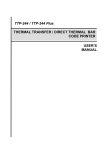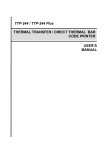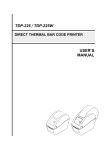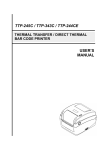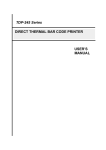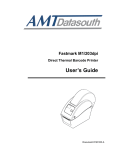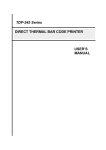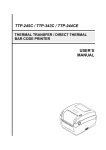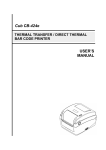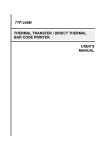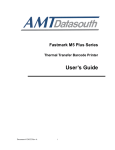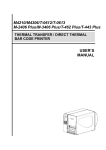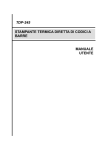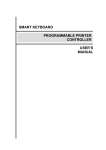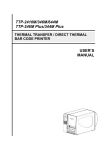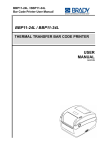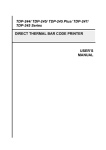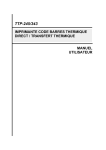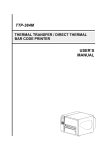Download TDP-245 Series USER`S MANUAL DIRECT THERMAL
Transcript
TDP-245 Series DIRECT THERMAL BAR CODE PRINTER USER’S MANUAL Contents COPYRIGHT DECLARATION ...............................................................................1 COMPLIANCES ................................................................................................1 1. Introduction.........................................................................................3 2. Getting Started ....................................................................................3 2.1 Unpacking and Inspection ...............................................................3 2.2 Equipment Checklist .......................................................................3 2.3 Printer Parts ....................................................................................4 2.3.1 Front View ................................................................................4 2.3.2 Rear View .................................................................................4 3 Setup.....................................................................................................5 3.1 Setting Up the Printer ......................................................................5 3.2 Loading Label Stock........................................................................6 3.3 Peel-Off Installation Assembly (Option)...........................................7 3.4 Loading Label for Peel-off Mode (Option) .....................................10 3.5 External Label Roll Mount Installation (Option) .............................12 3.6 Cutter Module Installation (Option)................................................13 3.7 Loading Label in Cutter Mode .......................................................15 3.8 Internal Ethernet Print Server Module Installation (Option) ...........16 4. Power on Utilities..............................................................................20 4.1 Gap/Black Mark Sensor Calibration ..............................................20 4.2 Gap/Black Mark Calibration, Self-test, Dump Mode ......................21 4.3 Printer Initialization ........................................................................24 4.4 Set Black Mark Sensor as Media Sensor and Calibrate the Black Mark Sensor........................................................................................25 4.5 Set Gap Sensor as Media Sensor and Calibrate the Gap Sensor.25 4.6 Skip AUTO.BAS ............................................................................25 5. Maintenance ......................................................................................26 5.1 Cleaning ........................................................................................26 6. Troubleshooting................................................................................27 6.1 LED Status ....................................................................................27 6.2 Print Quality...................................................................................28 7. LED and Button Operation...............................................................29 7.1 LED ...............................................................................................29 7.2 Button Operation ...........................................................................29 i Copyright Declaration Information in this subject to change without notice and does not represent a commitment on the part of TSC Auto ID Technology Co., Ltd.. No part of this manual may be reproduced or transmitted in any form by any means, for any purpose other than the purchaser’s personal use, without the expressed written permission of T TSC Auto ID Technology Co., Ltd.. The TrueType font engine is developed from the “FreeType Project" by David Turner, Robert Wilhelm, and Werner Lemberg; and all other products referred on this document are the trade mark or the registered trade mark of each belonged companies. Compliances CE Class B: EN55022: 1998+A1: 2000+A2: 2003 EN55024: 1998+A1: 2001+A2: 2003 IEC 61000-4 Series EN61000-3-2: 2006 & EN61000-3-3: 1995+A1: 2001 FCC Part 15, Class B UL, CUL C-Tick: CFR 47, Part 15/CISPR 22 3rd Edition: 1997, Class B ANSI C63.4: 2003 Canadian ICES-003 TÜV-GS: EN60950: 2000 Wichtige Sicherheits-Hinweise 1. Bitte lesen Sie Diese Hinweis sorgfältig durch 2. Heben Sie diese Anleitung fűr den späteren Gebrauch auf. 3. Vor jedem Reinigen ist das Gerät vom Stromentz zu trennen. Verwenden Sie Keine Flűssig-oder Aerosolreiniger. Am besten eignet sich ein angefeuchtetes Tuch zur Reinigung. 4. Die Netzanschlußsteckdose soll nahe dem Gerät angebraucht und leicht zugänglich sein. 5. Das Gerät ist vor Feuchtigkeit zu schűtzen. 6. Bei der Aufstellung des Gerätes ist auf sicheren Stand zu achten. Ein Kippen oder Fallen könnte Beschädigungen hervorrufen. 7. Beáchten Sie beim Anschluß an das stromnetz die Anschlußwerte. 1 8. Dieses das Gerät kann bis zu einer Außentemperatur von maximal 40℃ betieben werden. 2 1. Introduction Thank you for purchasing the TSC TDP-245 Series Direct Thermal Bar Code Printer. Although it is a compact desktop printer, it is reliable and with superior throughput performance. This printer provides both thermal transfer and direct thermal printing at user selectable speed of: 2.0, 3.0, 4.0 or 5.0 inches per second. It accepts roll feed, die-cut, and fan-fold labels for both thermal transfer and direct thermal printing. All common bar codes formats are available. Fonts and bar codes can be printed in 4 directions, 8 different alphanumeric bitmap fonts and a build-in true type font capability. You will enjoy high throughput for printing labels with this printer. 2. Getting Started 2.1 Unpacking and Inspection This printer has been specially packaged to withstand damage during shipping. Please carefully inspect the packaging and printer upon receiving the bar code printer. Please retain the packaging materials in cover you need to reship the printer. 2.2 Equipment Checklist One printer unit One Windows labeling software/driver CD disk One sample label roll One label spindle (1 inch diameter core) Two label spindle fixed tabs Two 1.5” core adapters One Centronics interface cable One auto switching power supply. One power cord. One quick start guide If any parts are missing, please contact the Customer Service Department of your purchased reseller or distributor. 3 Options Peel off module External label roll mount. Label spindle (3-inch diameter core). Programmable keyboard (KU-007 series) Stand-alone LCD keyboard (KP-200) Automatic cutter module External Ethernet print server External 802.11b/g wireless print server 2.3 Printer Parts 2.3.1 Front View Clear Window Top Cover LED Indicator Feed Button Label Opening Top Cover Open Lever Backing Paper Opening Front Panel Fig.1 Top Front View 2.3.2 Rear View 1. USB Interface 2. Centronics Interface 3. RS-232C DB-9 Interface 4. Power Jack 5. Power Switch 6 6. 1 2 3 4 5 Fig.2 Rear View 4 Rear Label Guide 3 Setup 3.1 Setting Up the Printer 1. Place the printer on a flat, secure surface. 2. Make sure the power switch is off. 3. Connect the printer to the computer with the Centronics or USB cable. 4 Plug the DC power cord into the power jack at the rear of the printer, and then plug the AC power cord into a properly grounded receptacle. Plug USB Power Switch Centronics RS-232C Power Jack Power Supply Power Cord Fig. 5 Attach a power supply to a printer 5 3.2 Loading Label Stock 1. Insert a 1” label spindle into a paper roll (If your paper core is 1 inch, remove the 1.5 inch core adapter from the fixing tab). Label Roll 1.5” Core Adapter Fixing Tab Printing Side Face up 1” Label Spindle Fig 6 Label roll installation (I) 2. Open the printer’s top cover by releasing the green top cover open levers located on both sides of the printer and lifting the top cover. 3. Place a roll of paper into internal paper roll mount. 4. Feed the paper, printing side face up, through the label guides and place the label over the platen. 5. Adjust the black center-biased label guides in or out by turning adjustment knob so they are slightly touch the edges of the label backing. Label Guide Label Roll Mount Adjustment Knob Platen Fig. 7 Label roll installation (II) 6 6. Close the printer top cover slowly and make sure the cover locks levers securely. Note: Failure to securely close and lock the cover will result in poor print quality. Fig. 8 Close the top cover completely 3.3 Peel-Off Installation Assembly (Option) 1. 2. Open the top cover. Unscrew the 6 screws in the lower inner cover. Screws Screws 3. Upside down the printer. 4. Unscrew the 2 screws at the lower inner cover 7 Remove the screw Remove the screw 5. Remove the screw at memory card cover. Screw 6. Hold the lower cover and lift up the top cover opening levers to separate the lower inner cover from the lower cover. Lower inner cover Lower cover 7. Thread the harness red connector through the cable hole at the front side of lower inner cover. Plug the red peel off module harness connector at the location JP17 on the main board. Place lower inner cover to the lower cover. Install the peel-off 8 module to the lower inner cover slot. Peel-off module assembly Install one side first and install another side 8. 9. Gently push peel-off panel to lock to the lower inner cover. Reassemble parts in reverse procedures after installing the module. 9 3.4 Loading Label for Peel-off Mode (Option) 1. Open the peel-off module by pulling it out. Peel-off Roller Peel-off Panel Fig. 9 Open the peel-off panel 2. Thread the label, printing side facing up, through the label guides and place it on top of the platen. 3. Thread the label through the liner opening, which is beneath the roller. 4. Adjust the black center-biased label guides by turning adjustment knob to fit the edge of the label backing. Adjustment Knob Roller Peel-off panel Fig. 10 Loading label for peel-off mode 5. Push the peel-off panel back to the printer. 10 6. Close the top cover. Fig. 11 Label loaded completely in peel-off mode 11 3.5 External Label Roll Mount Installation (Option) 1. Attach an external label roll mount on the bottom of the printer. 2. Install a roll of label on the external label roll mount. Label External Label Roll Mount Fig. 12 External label roll mount installation (I) 3. Feed the label to the external label feed opening through the rear label guide. External Label Feed Opening Rear Label Guide Fig. 13 External label roll mount installation (II) 4. Open the printer top cover by pulling the top cover open levers. 5. Thread the label, printing side face up, through the label guide and place it on top the platen. 6. Adjust the label guides by turning adjustment knob to fit the edge of the label backing. 7. Close the printer top cover. 12 3.6 Cutter Module Installation (Option) 1. Pull the top cover open levers to open the top cover. 2. Remove the front panel from the lower cover. 3. Remove 6 screws on the lower inner cover. Screws Screws Fig. 14 Remove 6 screws from lower inner cover 4. Upside down the printer. 5. Remove two screws at the hinge 6. Remove 1 screw at bottom memory card cover. 13 Screw Fig. 15 Remove 1 screw from bottom 7. Hold the lower cover and lift up the lower inner cover. 8. Arrange the cutter module harness through the bezel. 9. Connect the cutter module harness to the 4-pin socket on printer PCB. Bezel Socket Fig. 16 Cutter module harness arrangement 10. Reassemble lower inner cover back to the lower cover. 11. Install the cutter module into the niche of the printer. 14 Niche Fig. 17 Cutter module installation 12. Ressemble the parts in the reverse order. 13. Close the top cover. 3.7 Loading Label in Cutter Mode 1. 2. 3. 4. Open the printer top cover. Insert the label spindle into label roller Place a label roll to label roll mount. Thread the paper, printing side face up, through the label guide, platen and cutter module paper outlet. Label Guide Adjustment Knob Cutter Paper Opening Platen Cutter Fig. 18 Label installation in cutter mode 5. Adjust the black center-biased label guides to fit edge of the label backing. 6. Close the top cover 15 . Fig. 19 Label installation in cutter mode completed 3.8 Internal Ethernet Print Server Module Installation (Option) 1. Break through the plastic partial connected at the rear side of lower cover RJ45 interface opening. RJ45 interface opening Remove the screw 2. Remove the screw from the main board. Fasten the copper pillar and plastic pillar. 16 Plastic pillar Copper pillar 3. Fasten the RJ45 connector daughter board on the plastic and copper pillar. The ground wire from the mechanism must be screwed on the daughter board with copper pillar. Ground wire Screws RJ45 connector daughter board 4. Connect the print server module interface cable (36PIN) and RJ45 interface cable to print server module. Print server module interface cable RJ45 interface cable 17 5. Remove the 2 screws from the motor bracket and 1 screw in the lower inner cover to install the internal print server. Screw Screws 6. Install the print server module in printer lower inner cover with 3 screws. Screw Screws Internal Print Server Module 7. Plug the RJ45 white connector to the RJ45 daughter board connector. 8. Plug the print server module interface cable to connector J1A and J1B on the PCB, the left side harness (with red wire at the left side) is for J1A, the right side harness location is for J1B. 18 9. Plug the 2 PIN connector on PCB JP26 connector for 5V DC power. 8 PIN connector J1A JP26 J1B 19 4. Power on Utilities There are six power-on utilities to set up and test printer hardware. These utilities are activated by pressing FEED button and by turning on the printer power simultaneously. The utilities are listed as below: 1. Gap/Black mark sensor calibration 2. Gap/black mark sensor calibration, Self-test and Dump mode 3. Printer initialization 4. Set black mark as media sensor and calibrate the black mark sensor 5. Set gap sensor as media sensor and calibrate the gap sensor 6. Skip AUTO.BAS 4.1 Gap/Black Mark Sensor Calibration Gap/black mark sensor sensitivity should be calibrated at the following conditions: 1. A brand new printer 2. Change label stock. 3. Printer initialization. Please follow the steps below to calibrate the gap/black sensor: 1.Turn off the power switch. 2. Hold on the button then turn on the power switch. 3 Release the button when LED becomes red and blinking. (Any red will do during the 5 blinks). It will calibrate the gap/black mark sensor sensitivity. The LED color will be changed as following order: Amber red (5 blinks) amber (5 blinks) green (5 blinks) (5 blinks) red/amber (5 blinks) solid green It calibrates the sensor and measures the label length. green/amber Note: Please select gap or black mark sensor by GAP or BLINE command prior to calibrate the sensor. For more information about GAP and BLINE command, please refer to TSPL2 programming manual. 20 4.2 Gap/Black Mark Calibration, Self-test, Dump Mode While calibrate the gap/black mark sensor, printer will measure the label length, print the internal configuration (self-test) and then enter the dump mode. Please follow the steps as below. 1.Turn off the power switch. 2. Hold on the button then turn on the power switch. 3. Release the button when LED becomes amber and blinking. (Any amber will do during the 5 blinks). The LED color will be changed as following order. Amber red (5 blinks) amber (5 blinks) green (5 blinks) green/amber (5 blinks) red/amber (5 blinks) solid green It calibrates the sensor and measures the label length and prints internal settings then enter the dump mode. Note: Please select gap or black mark sensor by GAP or BLINE command prior to calibrate the sensor. For more information about GAP and BLINE command, please refer to TSPL2 programming manual. 21 Self-test Printer will print the printer configuration after gap/black mark sensor calibration. Self-test printout can be used to check if there is any dot damage on the heater element, printer configurations and available memory space. Print head check pattern Firmware version Firmware checksum Printed mileage (meter) Serial port configuration Country code Print speed (inch/sec) Print darkness Label size (inch) Gap distance (inch) Gap/black mark sensor sensitivity Numbers of download files Total & available memory space Self-test printout Note: 1. The physical flash memory for RoHS compliant version is 2MB Flash and 2MB DRAM. 2. System occupies 960 KB in Flash memory so total flash memory space for user downloading is 1088 KB 3. System occupies 1792 KB in DRAM so total DRAM memory space for user downloading is 256 KB 22 Dump mode Printer will enter dump mode after printing printer configuration. In the dump mode, all characters will be printed in 2 columns as following. The left side characters are received from your system and right side data are the corresponding hexadecimal value of the characters. It allows users or engineers to verify and debug the program. ASCII Data Dump mode printout Note: Turn off and on the power switch to reset the printer for normal printing. 23 4.3 Printer Initialization Printer initialization is used to clear DRAM and restore printer settings to defaults. The only one exception is ribbon sensitivity, which will note be restored to default. Printer initialization is activated by the following procedures. 1. Turn off the power switch. 2. Hold on the button then turn on the power switch. 3. Release the button when LED turns green after 5 amber blinks. (Any green will do during the 5 blinks). The LED color will be changed as following: Amber red (5 blinks) amber (5 blinks) green (5 blinks) (5 blinks) red/amber (5 blinks) solid green green/amber Printer configuration will be restore to defaults as below after initialization. Parameter Default setting Speed TDP-245, 127 mm/sec (5 ips) Density 8 Label Width 4.25” (108.0 mm) Label Height 2.5” (63.4 mm) Media Sensor Type Gap sensor Gap Setting 0.12” (3.0 mm) Print Direction 0 Reference Point 0,0 (upper left corner) Offset 0 Tear Mode On Peel off Mode Off Cutter Mode Off Serial Port Settings 9600 bps, none parity, 8 data bits, 1 stop bit Code Page 850 Country Code 001 Clear Flash Memory No Note: Always do gap/black mark sensor calibration after printer initialization. 24 4.4 Set Black Mark Sensor as Media Sensor and Calibrate the Black Mark Sensor Please follow the steps as below. 1. Turn off the power switch. 2. Hold on the button then turn on the power switch. 3. Release the button when LED turns green/amber after 5 green blinks. (Any green/amber will do during the 5 blinks). The LED color will be changed as following: Amber red (5 blinks) amber (5 blinks) green (5 blinks) (5 blinks) red/amber (5 blinks) solid green green/amber 4.5 Set Gap Sensor as Media Sensor and Calibrate the Gap Sensor Please follow the steps as below. 1. Turn off the power switch. 2. Hold on the button then turn on the power switch. 3. Release the button when LED turns red/amber after 5 green/amber blinks. (Any red/amber will do during the 5 blinks). The LED color will be changed as following: Amber red (5 blinks) amber (5 blinks) green (5 blinks) green/amber (5 blinks) red/amber (5 blinks) solid green 4.6 Skip AUTO.BAS TSPL2 programming language allows user to download an auto execution file to flash memory. Printer will run the AUTO.BAS program immediately when turning on printer power. The AUTO.BAS program can be interrupted without running the program by the power-on utility. Please follow the steps as below. 1. Turn off printer power. 2. Press the FEED button and then turn on power. 3. Release the FEED button when LED becomes solid green. The LED color will be changed as following: Amber red (5 blinks) amber (5 blinks) green (5 blinks) (5 blinks) red/amber (5 blinks) solid green 4. Printer will be interrupted to run the AUTO.BAS program. 25 green/amber 5. Maintenance 5.1 Cleaning Use one or more of the following supplies that meets your needs: Cotton swab Lint-free cloth Vacuum 100% ethanol The cleaning process is described as following: Printer Part Method Printer Head 1. Always turn off the printer before cleaning the print head. 2. Allow the printhead to cool for a minimum of one minute. 3. Use a cotton swab and 100% ethanol to clean the print head surface. Platen Roller 1. Turn the power off. 2. Rotate the platen roller and wipe it thoroughly with 100% ethanol and a cotton swab, or lint-free cloth. Exterior Wipe it with water-dampened cloth. Interior Brush or air blow. Note: Do not touch printer head by hand. If you touch it careless, please use ethanol to clean it. It’s industry alcohol. Please do not use regular alcohol, which may damage the printer head. You may have to clean the supply sensors more often if you frequently receive supply error messages. 26 6. Troubleshooting This section lists the common problems that according to the LED status and other problems you may encounter when operating the printer. Also, it provides solutions. 6.1 LED Status LED Status / Color Printer Status Solution Number Off off 1 Solid Green on 2 Flash Green Paused 3 Flash Red Stopped 4 1. No power. Turn on the power switch. Check if the green LED is lit on power supply. If it is not lit on, power supply is broken. Check both power connection from the power cord to the power supply and from the power supply to the printer power jack. 2. The printer is on and ready to use. No action necessary. 3. The printer is paused. Press the feed button to resume printing. 4. The printer out of label or the printer setting is not correct Out of label Load a roll of label and follow the instructions in Loading the Paper And then press the feed button to resume printing. Printer setting is not correct Initialize the printer by following the instructions in “Power on Utility”. 27 6.2 Print Quality Continuous feeding labels The printer setting may go wrong. Please do the Initialization and Gap/Black Mark Calibration. No print on the label Is the label loaded correctly? Follow the instructions in Loading the Paper. Poor print quality Top cover is not closed properly. Close the top cover completely. Clean the thermal print head. Adjust the print density setting. 28 7. LED and Button Operation 7.1 LED LED Color Description Green/ Solid This illuminates that the power is on and the device is ready to use. Green/ Flash This illuminates that the system is downloading data from PC to memory and the printer is paused. Amber This illuminates that the system is clearing data from printer. Red / Solid This illuminates printer head open, cutter error. Red / Flash This illuminates a printing error, such as paper empty, paper jam, or memory error etc. 7.2 Button Operation Feed Pause Press the button when the LED is green. It feeds the label to the beginning of the next label. Press the feed button during printing. The printing job is suspended. Gap/Black Mark 1.Turn off the power switch. Sensor Calibration 2. Hold on the button then turn on the power switch. 3 Release the button when LED becomes red and blinking. (Any red will do during the 5 blinks). It will calibrate the gap/black mark sensor sensitivity. The LED color will be changed as following order: Amber red (5 blinks) amber (5 blinks) green (5 blinks) green/amber (5 blinks) red/amber (5 blinks) solid green It calibrates the sensor and measures the label length. Note: Please select gap or black mark sensor by GAP or BLINE command prior to calibrate the sensor. For more information about GAP and BLINE command, please refer to TSPL2 programming manual. 29 Gap/Black Mark 1.Turn off the power switch. Sensor Calibratio, 2. Hold on the button then turn on the power switch. 3. Release the button when LED becomes amber and blinking. Label Length (Any amber will do during the 5 blinks). Measurement, The LED color will be changed as following order. Self Test and enter Amber red (5 blinks) amber (5 blinks) green Dump Mode (5 blinks) green/amber (5 blinks) red/amber (5 blinks) solid green It calibrates the sensor and measures the label length and prints internal settings then enter the dump mode. Note: Please select gap or black mark sensor by GAP or BLINE command prior to calibrate the sensor. For more information about GAP and BLINE command, please refer to TSPL2 programming manual. Printer Initialization 1. Turn off the power switch. 2. Hold on the button then turn on the power switch. 3. Release the button when LED turns green after 5 amber blinks. (Any green will do during the 5 blinks). The LED color will be changed as following: Amber red (5 blinks) amber (5 blinks) green (5 blinks) green/amber (5 blinks) red/amber (5 blinks) solid green Always do gap/black mark sensor calibration after printer initialization. Set Black Mark 1. Turn off the power switch. Sensor as Media 2. Hold on the button then turn on the power switch. 3. Release the button when LED turns green/amber after 5 Sensor and Calibrate the Black green blinks. (Any green/amber will do during the 5 blinks). The LED color will be changed as following: Mark Sensor Amber red (5 blinks) amber (5 blinks) green (5 blinks) blinks) green/amber (5 blinks) solid green 30 red/amber (5 Set Gap Sensor as 1. Turn off the power switch. Media Sensor and 2. Hold on the button then turn on the power switch. Calibrate the Gap 3. Release the button when LED turns red/amber after 5 green/amber blinks. (Any red/amber will do during the 5 Sensor blinks). The LED color will be changed as following: Amber red (5 blinks) amber (5 blinks) green (5 blinks) blinks) Skip AUTO.BAS green/amber (5 blinks) solid green red/amber (5 1. Turn off printer power. 2. Press the FEED button and then turn on power. 3. Release the FEED button when LED becomes solid green. The LED color will be changed as following: Amber red (5 blinks) amber (5 blinks) green (5 blinks) green/amber (5 blinks) red/amber (5 blinks) solid green 4. Printer will be interrupted to run the AUTO.BAS program. 31 32 Headquarters / Factory No. 35, Sec. 2, Ligong 1st Rd., Wujie Town , I-Lan County, Taiwan 268, R.O.C. TEL: +886-3-990-6677 FAX: +886-3-990-5577 Web site: www.tscprinters.com E-mail: [email protected] [email protected] Taipei Office 11F, No. 205, Sec. 3, Beishin Rd., Shindian City, Taipei 231, Taiwan, R.O.C.Taiwan 268, R.O.C. TEL: +886-2-8913-1308 FAX: +886-2-8913-1808



































